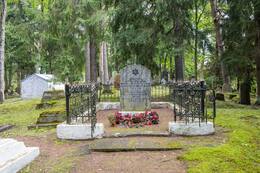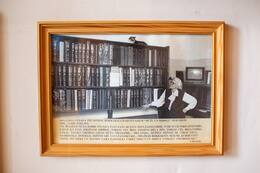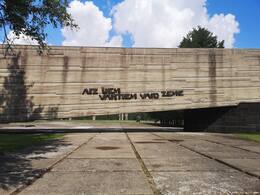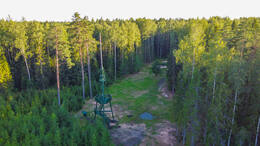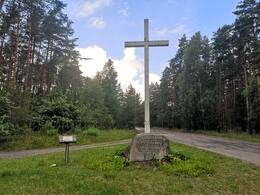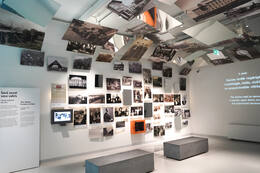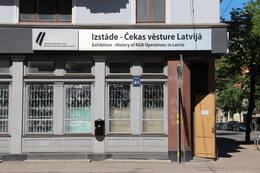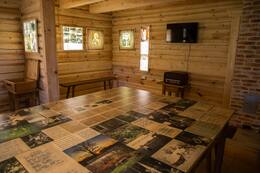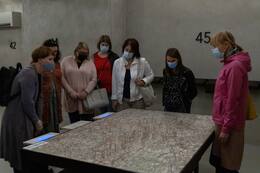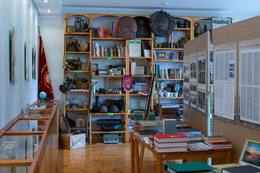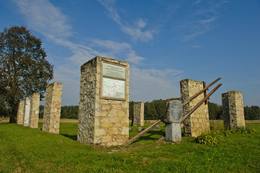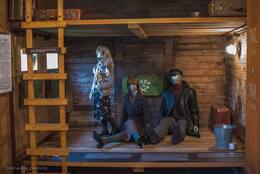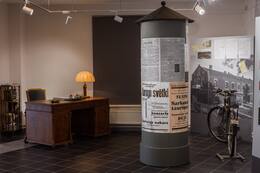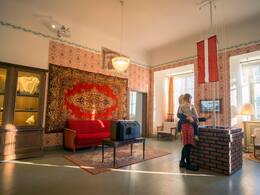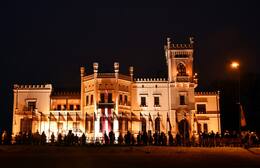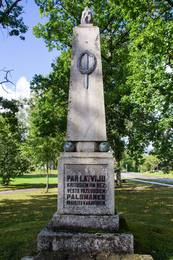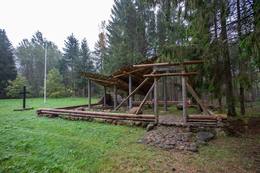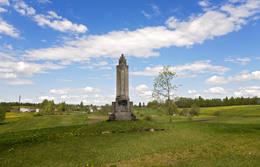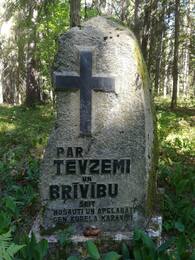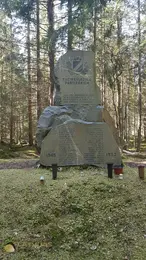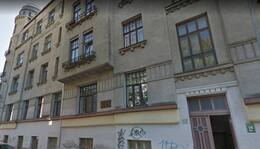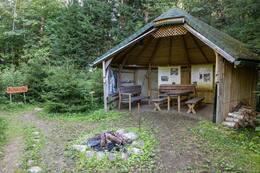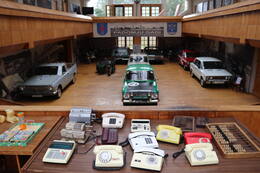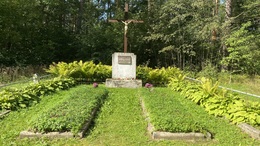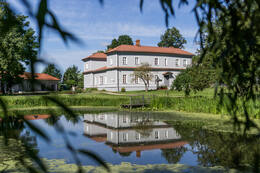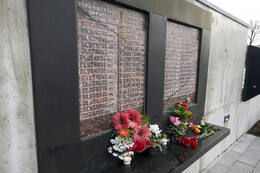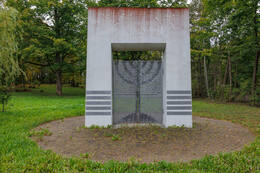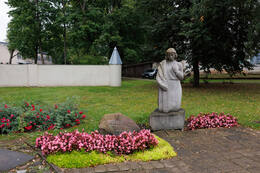Represijas II WW2, IV Padomju okupācija
Represijas - atsevišķu personu un iedzīvotāju kategoriju vajāšana, apspiešana un ierobežošana, ko lieto varas iestādes. Vardarbīgas represijas pret Latvijas iedzīvotājiem raksturo gan PSRS, gan nacistiskās Vācijas okupācijas režīmus.
Lai novērstu pretošanos un neapmierinātības izpausmes ar jauno režīmu, jau 1940. gada vasarā padomju okupācijas vara sāka īstenot sistemātiskas represijas pret Latvijas pilsoņiem, ko realizēja PSRS NKVD (IeTK – Iekšlietu Tautas komisariāts) represīvās organizācijas un pēc to parauga uz vietas veidotās struktūras. Politisku iemeslu dēļ 1940.-1941. gadā tika arestēti vairāk kā 7000 Latvijas iedzīvotāju, neskaitot izsūtītos. Lielākā represīvā akcija bija 1941. gada 14. jūnija deportācija, kuras laikā uz PSRS no Latvijas lopu vagonos tika izvesti 15 424 iedzīvotāji. Arestētie tika nosūtīti uz GULAG labošanas darbu nometnēm, savukārt, administratīvi izsūtītie tika nometināti Sibīrijas kolhozos.
1941. gada vasarā Latvijas teritorija nonāca nacistiskās Vācijas varā, kuras okupācijas režīms bija ne mazāk brutāls kā padomju. Lielākais nacistiskās Vācijas īstenotais noziegums Latvijas teritorijā bija genocīds pret ebrejiem jeb holokausts. Hitlera rasistiskās ideoloģijas dēļ tika sistemātiski iznīcināta gandrīz visa vairākus simtus gadu senā Latvijas ebreju kopiena – ap 70 000 ebreju un vēl apmēram 20 000 ebreju no citām Austrumeiropas teritorijām. Ebreju nošaušanas akcijas lielākoties tika īstenotas jau 1941. gadā. Tāpat Vācijas okupācijas režīms vērsās arī pret režīma politiskajiem pretiniekiem un padomju aktīvistiem, kuri nebija paspējuši evakuēties uz Krieviju PSRS-Vācijas kara sākumā.
No 1944. gada Latvijas teritorijā atradās un tika atjaunota padomju okupācijas vara. Otrreizējā padomju okupācija nesa jaunas politiskās represijas. Pirmajos pēckara gados Latvijā bija aktīva bruņota nacionālā pretošanās kustība jeb nacionālie partizāni. To mērķis bija atjaunot Latvijas neatkarību. 20. gs. 40. gados notika šo pretošanās kustības dalībnieku un to atbalstītāju masveidīgi aresti, tika sodīti arī tie Latvijas iedzīvotāji, kuri brīvprātīgi vai piespiedu kārtā bija sadarbojušies ar Vācijas okupācijas režīmu un arī citas iedzīvotāju grupas. 1944.-1945. gadā tika arestēti ap 38 000 cilvēku. Lielākā īstenotā soda akcija padomju okupācijas laikā pēc 2. pasaules kara bija 1949. gada 25. marta deportācija. Tās laikā no Latvijas uz Sibīriju un citiem PSRS attāliem apgabaliem izsūtīja 42 195 Latvijas iedzīvotājus, lielākoties sievietes un bērnus. Tiek lēsts, ka pirmās padomju okupācijas laikā 1940.-1941. gadā un no 1945. līdz 1953. gadam padomju represijās Latvijā cietuši vai gājuši bojā 140–190 000 cilvēku.
Bailēs no padomju okupācijas režīma atgriešanās 1944. gadā sākās arī bēgļu kustība no Latvijas uz Rietumiem pa jūras un sauszemes ceļiem.
Papildus izziņas avoti
Totalitāro okupācijas režīmu represijas pret Latvijas iedzīvotājiem. 1940.-1953. Latvijas Nacionālais Vēstures muzejs: http://lnvm.lv/?page_id=3976
Totalitārie okupācijas režīmi Latvijā 1940.-1964.gadā. Latvijas vēsturnieku komisijas pētījumi. Latvijas vēsturnieku komisijas raksti. 13. sējums. Rīga, 2004. https://www.president.lv/storage/kcfinder/files/item_1618_Vesturnieku_komisijas_raksti_13_sejums.pdf
Saistītās laikalīnijas
Saistītie objekti
Varakļānu ebreju kapi - piemiņas vieta vācu-fašistiskā terora upuriem
Varakļānu ebreju kapi, Kapsētas ielas galā.
Apskatāmi divi pieminekļi, kurus pēc kara Varakļānu ebreju kapsētā uzstādīja izdzīvojušie radi un tuvinieki.
Viens no tiem atrodas pie kapsētas žoga, kur notika ebreju masveida iznīcināšana. Uzraksts uz tā krievu un jidiša valodā vēsta: “Mēs mūžīgi sērosim par mūsu vecākiem, brāļiem un māsām, kas gāja bojā no fašistu rokām 1941.gadā”. Otrs piemineklis atrodas kapsētas iekšpusē; vietā, kur nogalinātie ebreji vēlāk pārapbedīti, arī uz tā ir uzraksts jidiša un krievu valodā: “Mūžīga piemiņa vācu-fašistiskā terora upuriem – Varakļānu ebrejiem, zvērīgi nogalinātiem 1941.g.4.augustā”.
Nacistiskās Vācijas karaspēks Varakļānos ienāca 1941.g. jūlija sākumā un jau ar pirmajām dienām uzsāka ebreju ierobežošanu un atsevišķas slepkavības. Netālu no Ebreju kapsētas tika izveidots nosacīts geto, uz kuru visiem ebrejiem bija jāpārceļas. 4. augustā Ebreju kapsētas teritorijā vācu SD vienība (“Arāja komanda”) ar vietējo pašaizsardzībnieku palīdzību nošāva praktiski visus Varakļānu ebrejus (ap 540 cilvēku).
Katru gadu augusta pirmajā svētdienā Varakļānu ebreju kapos notiek piemiņas pasākums, kas veltīts Varakļānos nogalinātajiem ebrejiem.
Melānijas Vanagas muzejs un Sibīrijas zemnīca
Muzejā apskatāmi materiāli par rakstnieces un kultūrvēsturnieces dzīvi, literāro darbību, dzimtu un likteņiem. Videomateriāli par Sibīriju un tur dzīvojošajiem izsūtītajiem latviešiem. Sibīrijas zemnīca – neklātienes ceļojums uz rakstnieces izsūtījuma vietu Krasnojarskas novada Tjuhtjetā. Zemnīcas izskats un iekārtojums rada reālu priekšstatu par dzīvi svešumā. Zemnīcā ir unikāli, vēsturiski priekšmeti, atvesti no Tjuhtjetas muzeja – bērza tāss trauks tujesok, māla krūze – krinka un petrolejas lampa. Muzejā ir videointervijas ar novada politiski represētajiem cilvēkiem un 18 M.Vanagas grāmatas “Veļupes krastā” varoņiem.
Melānijas Vanagas muzeja virtuālā ekspozīcija "ESI PATS!" http://esipats.lv
Muzeja virtuālā ekspozīcija „ESI PATS!” atklāj piecu deportēto bērnu pieredzi. Ekspozīcijas varoņus – piecgadīgo Intu Broku, Andri Eglīti un Ivaru Kārkliņu, astoņgadīgo Alni Vanagu un vienpadsmitgadīgo Ilgu Hāgemani, kā arī viņu vecākus - padomju vara nepamatoti apsūdzēja „dzimtenes nodevībā”.
Salaspils memoriāls
Atrodas Salaspils novadā, 1,2 kilometru attālumā no Rīgas - Daugavpils šosejas.
Salaspils memoriāls tika atklāts 1967. gadā vietā, kur 2. pasaules kara laikā atradās Salaspils nometne. Mītiem un puspatiesībām apvīta vieta, kas izmantota Padomju propagandai. Latvijas okupācijas varu - nacistu noziegumu un komunistiskās ideoloģijas piemērs.
Salaspilī bija represīva nometne, kas ietilpa Vācijas soda vietu sistēmā. Tai bija līdzības, bet ne atbilstības ar koncentrācijas nometnēm. Izveidota, lai Rīgas cietumos nebūtu nesamērīgi liels ieslodzīto skaits. Nometne bija “paplašināts policijas cietums”, kas vēlāk paplašināts ar citām nodaļām. Ieslodzīja visdažādākos cilvēkus - ebrejus, Sarkanās armijas karagūstekņus, darba kavētājus, politieslodzītos, kriminālnoziedzniekus, prostitūtas, latviešu pretošanās kustības locekļus, baltiešu karavīrus, kuri atradās Vācijas armijas vai policijas dienestos u.c. Nometnē vienlaicīgi uzturējās līdz 2200 ieslodzīto. Galvenie nāves (~2000) cēloņi bija slikts uzturs, darba apstākļi, miesas sodi un slimības.
Mūsdienās var aplūkot iespaidīgu memoriālo ansambli. Viens no lielākajiem šāda veida objektiem pasaulē. Salaspils memoriāla brīvdabas teritorija ir pieejama 24h. Ekskursijām nepieciešama iepriekšēja pieteikšanās pa tālr. +371 67216367 vai e-pastā salaspils.memorials@gmail.com.
Memoriāls komunistiskā genocīda upuriem
Šis memoriāls atrodas Pilistveres kapos.
Memoriāla izveide sākās 1988. gadā, un 300 cilvēku pulcējās pie šī pasākuma. Brīvprātīgo kopīgie centieni turpinās līdz pat šai dienai, katru gadu piemiņas zīmei veicot uzlabojumus. Ideja par memoriālu radusies brīvības cīnītājai Laglei Parekai.
Tās centrā atrodas akmeņu krūze, ko no Igaunijas, Sibīrijas un vēl tālākām vietām atveduši igauņu emigranti. Cairnu vainago liels krusts. Krusta pakāje ir simboliska kapavieta, pie kuras igauņi nes klintis, lai pieminētu uz Sibīriju izsūtītos tuviniekus.
Cairnu ieskauj laukakmeņi — pa vienam katram apgabalam, kurus projektējis Aate-Heli Õun un kas uzstādīti pa posmiem.
Pie memoriāla atrodas piemiņas akmeņi Černobiļas radiācijas upuriem, mežabrāļiem, NKVD darba kolonnās iesauktajiem, Igaunijas brīvprātīgajiem Somijas armijā un brīvības cīnītājiem. Tos visus izstrādāja Endels Palmiste.
Papildus kalvam pie memoriāla ir iestādīts vairāk nekā 2000 piemiņas koku birzs. Birzu projektējis slavenais ainavu arhitekts Andress Lēvalds.
Vēsturiskajā Pilistveres pastorātā, kas kalpo kā galvenā ēka piemiņas vietā, atrodas arhīvs un Igaunijas Vēstures muzeja izstāde par Igaunijas okupāciju.
Litenes armijas vasaras nometne
Atrodas Litenes pagastā, mežā, netālu no Pededzes upes.
Litenes armijas vasaras nometne ir valsts nozīmes vēsturiska notikuma vieta.
Vienīgā vēsturiskā ēka, kura saglabājusies no nometnes laikiem - pārtikas noliktava, ēku pamati. Izveidota skatu platforma, kurā plīvo Latvijas karogs, novietoti soli, labiekārtota ugunskura vieta. Ar Aizsardzības ministrijas un Nacionālo bruņoto spēku atbalstu uzstādīts demilitarizēts lielgabals. Izvietotas informācijas plāksnes.
Litenes nometnes vieta būtu apskatāma kopā ar piemiņas vietu Litenes kapos - memoriāls "Sāpju siena".
Aizsākums Litenes nometnei meklējams 1935.gadā, kad Latvijas armijas Latgales divīzijai šeit sāka veidot vasaras nometņu kompleksu. Vairāki tūkstoši karavīru Litenē no maija līdz rudenim apguva kaujas taktikas iemaņas un šaušanas māku. 1941.gada vasarā Litenē armijas vasaras nometnē tika apcietināti Latvijas armijas virsnieki. Vairāki virsnieki tika nošauti uz vietas, pārējie - izsūtīti uz Sibīriju. 1941.gada 14.jūnijā Litenes un Ostroviešu nometnē, kas atradās aptuveni 10 kilometru attālumā no Litenes, apcietināja un deportēja uz Sibīriju vismaz 430 virsniekus.
Youtube kanāla "Latvijas armija" video "Litene - Latvijas armijas Katiņa"
Litenes armijas vasara nometnes teritorijā ir informācijas stendi latviešu un angļu valodā, gida pakalpojumi pieejama latviešu un krievu valodā - T. +371 29269823 un +371 29204507.
Memoriāls „Sāpju siena”
Artrodas Litenes kapos.
2001.gada 14.jūnijā Litenes kapos tika atklāts arhitektu Dinas Grūbes, Benitas un Daiņa Bērziņu, akmeņkaļu Ivara Feldberga un Sandra Skribnovska radītais memoriāls „Sāpju siena”, tā simbolizē 1941.gada nogalināto karavīru atdusas vietu. 1988.gada oktobrī bijušās Latvijas armijas vasaras nometnes teritorijā Sitas silā Litenes pagastā tika atrasti 1941.gada jūnijā padomju armijas noslepkavoto 11 virsnieku pīšļi. Lai gan tos neizdevās identificēt, tomēr 1989.gada 2.decembrī, iesvētot dievkalpojumā Gulbenes evaņģēliski luteriskajā baznīcā, svinīgi pārapbedīja Litenes kapos.
11 balti krusti, piemiņas plāksne un informācijas stendi.
Piemiņas vieta Baltais krusts Stopiņos
Atrodas mežā 50 m no autoceļa V36, posmā no Juglas papīrfabirkas ciemata uz autoceļu P4.
Laikā no 1941. gada 3. februāra līdz 25. martam šajā vietā četrās bedrēs tika aprakstas 23 cilvēku mirstīgās atliekas. Cietušie bija nošauti čekas ēkā Rīgā. Ekshumācija notika 1944. gada 27. aprīlī. Tajā laikā tika identificēti 14 apglabātie, mūsdienās izpētes rezultātā noskaidroti visi šajā vietā apglabātie.
Baltais krusts šajā vietā uzstādīts 1991. gada 12. jūlijā kā piemiņas zīme komunistu okupācijas režīma upuriem. Balto krustu izgatavoja un uzstādīja Stopiņu novada tautfrontieši un iedzīvotāji. 1998. gadā pie Baltā krusta uzstādīts tēlnieka Ulda Sterģa darinātais piemiņas akmens ar uzrakstu “Krievijas impērisma upuriem 1941”.
Šeit tika apglabāti: Jānis Bergmanis (1900-1941), Alberts Bļodnieks (1904-1941), Kārlis Goppers (1876-1941), Arveds Laane (1916-1941), Ernests Ošs-Oše (1882-1941), Antons Pacevičs (1901-1941), Jāzeps Pošeiko (1897-1941), Arnolds Smala (1912-1941), Jāzeps Stoļers (1903-1941), Valfrīds Vanks (1888-1941), Zenons Vjaksa (1904-1941), Viktors Kopilovs (1904-1941), Kārlis Prauls (1895-1941), Artūrs Salnājs (1904-1941), Jevgeņijs Simonovs (1896-1941), Eduards-Verners Anerauds (1897-1941), Efraims Gorons (1910-1941), Pēteris Ļaksa-Timinskis (1913-1941), Pēteris Melbārdis (1892-1941), Izraels Paļickis (1911-1941), Jānis Priedītis (1897-1941), Jānis-Arnolds Stālmanis (1913-1941), Aleksandrs Veinbergs (1884-1941).
Latvijas Okupācijas muzejs
Latvijas Okupācijas muzejs aicina izzināt Latvijas okupācijas stāstu no 1940. līdz 1991. gadam par Padomju Savienības un nacionālsociālistiskās Vācijas okupācijas režīmu valdīšanu.
Ekspozīcijas koncepcija, dizains un realizācija – dizaina birojs H2E.
Ekspozīcija atklāta 2022. gada 30. maijā.
www.okupacijasmuzejs.lv
+371 67229255
Stūra mājas izstāde "Čekas vēsture Latvijā"
Atrodas Rīgā, Brīvības un Stabu ielu krustojumā.
1911. gadā būvētais nams ir viens no skaistākajiem Rīgā. Tautā saukts par “Stūra māju”, ir baisākais Padomju okupācijas režīma simbols Latvijā. “Čeka” bija īpaši represīva struktūra - viens no PSRS varas balstiem. Tās darbība Latvijā cieši saistīta ar ēku Brīvības un Stabu ielas stūrī.
“Stūra mājā” čeka darbojās okupācijas laikā no 1940.gada līdz 1941. gadam un atkal, sākot no 1945.gada līdz 1991. gadam. Politiskās vajāšanas tiešā veidā skāra ap desmitiem tūkstošu Latvijas iedzīvotāju. Padomju varas pretinieku apkarošana turpinājās arī pēc 2. pasaules kara. Čekas darbības metodes nedaudz mainījās pēc Staļina nāves. Fizisku mocīšanu nomainīja psiholoģisks terors. Vairākums čekas aģentu bija latvieši (52%). Krievi bija otrā lielākā grupa - 23,7 %. 60,3% aģentu nebija Komunistiskās partijas biedri. Augstākā izglītība bija 26,9% aģentu. Sistēma bija veidota, lai iesaistītu vietējos iedzīvotājus un tādējādi panāktu kontroli pār sabiedrību. Čekas darbības metodes Latvijā nav pilnībā izpētītas. Darbinieku saraksti un dienesta lietas atrodas Krievijā. Latvijas varas iestādēm un pētniekiem tās nav pieejamas.
Mūsdienās var aplūkot Latvijas Okupācijas muzeja izstādi par “čekas” darbību Latvijā. Kopā ar gidu var izstaigāt cietuma kameras, gaiteņus, pagrabu un iekšpagalmu.
Broņislavas Martuževas dzejas klēts
Atrodas dzejnieces mājvietā, “Dārziņi 1”, Indrānu pagasts, Madonas novads.
Piemiņas vieta un muzejs - ekspozīcija, balss un video ierakstu liecības par Nacionālo pretošanās kustību un dzejnieces darbu, pagrīdē izdodot žurnālu, sacerot dzeju un dziesmas nacionālajiem partizāniem.
Rekonstruētajā klētī ir iekārtota inovatīva, ilgtspējīga piemiņas vieta, kur Dzejas klēts apcirkņos, apliecinot B. Martuževas mūža gaitu, tiek akcentēta arī Nacionālās pretošanās kustība.
B. Martuževa bija iesaistījusies pretošanās kustībā no pašiem tās pirmsākumiem. Martuževu mājas “Lazdiņas” (māja nav saglabājusies) bija patvērums arī LNPA vadītājam Pēterim Supem un viņa biedriem. Te 5 gadus savas mājas pagrīdē slēpās B.Martuževa, tikās ar partizāniem, rakstīja dzejas (arī veltījumus partizāniem: Pēterim Supem, Vilim Tomam, Smilgas grupai, Laiveniekam, Salnam, Celmiņam, Bruno Dunduram u.c.), sacerēja dziesmas un iemācīja tās partizāniem, kuri tās iznesa pa pagastiem - arī tautā zināmo “Jaunība”, kuru vēlāk kā bezsaimnieka mantu paņēma E. Rozenštrauhs.
Tagad viņas dziesmas (arī veltījumus partizāniem) pa pagastiem izdzied grupa “Baltie lāči” – dzejniece savas dziesmas 2009. gadā nodeva Andrim Baltacim, kurš vienmēr ir gatavs pagodināt dzejnieces vārdu pasākumos arī Lubānā.
Pagrīdē kopā ar Vili Tomu 1950. gadā tika izdots žurnāls “Dzimtene” (11 numuri, kurus ar roku katru 10 eksemplāros pārrakstīja B.Martuževa).
1951. gadā dzejniece, brālis, māsa, māte un Vilis Toms tika apcietināti, B.Martuževa no Sibīrijas atgriezās 1956.gadā.
Dzejas klēts ir kļuvusi atpazīstama gan novadā, gan Latvijā, to apmeklē gan vietējie iedzīvotāji, t.sk. skolēnu klases, gan individuāli, gan tūrisma grupas. Te ir iespēja ar caur dzejnieces mūža gaitu iepazīties arī Latvijas likteņgaitu, - ne tikai attēlos, bet arī balss un video liecībās.
Vēstures ekspozīcija "Sirdsapziņas ugunskurs"
Atrodas Pils ielā 12, Cēsīs, netālu no Cēsu pils laukuma.
Vēstures ekspozīcija "Sirdsapziņas ugunskurs" atklāj pārsteidzošus un varonību apliecinošus indivīdu pretošanās stāstus.
Ekspozīcija izveidota padomju laika īslaicīgās aizturēšanas izolatorā un vēsta par Latvijas okupāciju.
1940-tajos gados Latviju divreiz okupēja Padomju Savienība un nacionālsociālistiskā Vācija. Līdz pat 1950-to gadu vidum kādreizējā Cēsu apriņķa iedzīvotāji, tāpat kā viņu laikabiedri citviet Latvijā, aktīvi pretojās totalitārajiem okupācijas režīmiem.
Ekspozīcija sniedz padziļinātu ieskatu vietējās kopienas patriotismā un motivācijā. Laika līnija rosina izzināt Latvijas okupācijas norisi no 1939. līdz 1957. gadam un tematiski sakārtoti citāti no vietējiem laikrakstiem piedāvā salīdzināt abu okupācijas režīmu politisko propagandu.
Īslaicīgajai ieslodzīšanai paredzētās sešas kameras līdz mūsdienām saglabājušas tādas, kādas tās bija 1940./41. gadā un pēckara gados. Šeit, pirms nosūtīšanas uz čekas galveno ēku Rīgā, vairākas dienas, kamēr notika sākotnējā izmeklēšana un pratināšana, bija ieslodzīti tie Cēsu apriņķa iedzīvotāji, kurus aizturēja par visdažādākajām pretpadomju darbības izpausmēm – nacionālie partizāni, viņu atbalstītāji, jaunieši, kuri izplatīja “pretpadomju” satura lapiņas un citi “dzimtenes nodevēji”. Viss šeit ir īsts – kameras ar dzelzs durvīm, kur iebūvētas “kormuškas” (nelielas atveres ēdienu padošanai), koka nāras, ateja arestantiem, neliela virtuvīte ar krāsni, tipiskais padomju laika eļļas krāsu sienu krāsojums.
2019.gadā ekspozīcija ieguva Latvijas Dizaina gada balvā 3.vietu.
2015. gadā Pils ielas 12 pagalmā atklāja piemiņas sienu ar 643 padomju represijās bojāgājušo agrākā Cēsu apriņķa iedzīvotāju vārdiem – gan 1941. un 1949. gadā izsūtītajiem, gan nošautajiem un ar nāvi sodītajiem nacionālajiem partizāniem.
Otrā pusē ceļam apskatāma Cēsu “Stūra māja” - bijušais čekas nams.
Vaidavas pagasta novadpētniecības pastāvīgā ekspozīcija
Atrodas Vaidavas kultūras un amatniecības centrā.
Redzama ekspozīcija, kas veltīta 1949. gada deportāciju atcerei, kā arī vaidaviešu dalībai 1991.gada janvāra barikādēs Rīgā. Ekspozīcijā apskatāmas arī pasaules karu liecības (galvenokārt drukātie materiāli).
Dabas un vēstures objekti, muižas, izglītības vēsture, kultūra, ievērojami cilvēki, kolhoza laika materiāli, sadzīves saimniecības piederumi, naudas zīmes, avīzes, žurnāli par Vaidavas pagastu.
Komunistiskā terora upuru piemiņas vieta Jaunraunas pagasta represētajiem
Atrodas "Baižēni", Priekuļu pagastā
Piemiņas vieta represētajiem izveidota “Baižēnu” māju šķūņa drupu vietā, kurā 1949.gadā naktī uz 25.martu tika turēti 40 Jaunraunas pagasta iedzīvotāji, lai no rīta to ceļš vestu tālāk uz Lodes dzelzceļa staciju un Sibīriju.
Represēto vidū bija bērni līdz 1 gada vecumam un 87 gadus veci sirmgalvji.
Uz piemiņas plāksnes rakstīti arī to vārdi, kuri nošauti vai miruši izsūtījumā. Līdzās atrodas piemiņas akmeņi Lāčplēša kara ordeņa kavalieriem.
Deportāciju piemiņas vagons - muzejs pie Skrundas stacijas
Deportāciju vagons atrodas Skrundas stacijā pie pasažieru perona.
Vagons un pie tā esošais piemineklis veltīts 1941. un 1949. gada deportācijās cietušajiem Skrundas un tuvāko pagastu iedzīvotājiem. Piemiņas vieta iekārtota un atklāta 1998. gada 25. martā, bet vagons un ekspozīcija atjaunoti 2020. gadā. Ekspozīcijā redzami no tuvākās apkārtnes izsūtīto iedzīvotāju saraksti, aplūkojamas fotogrāfijas un lasāmi stāsti par izsūtījumā pieredzēto.
Skrundas stacija bija izvešanai nolemto cilvēku savākšanas punkts, viena no trim apriņķa stacijām, uz kuru tika atvesti cilvēki gan no Skrundas, gan Kuldīgas apkārtnes. 1941. gadā no šejienes uz Sibīriju, Krasnojarskas novadu izveda arī atjaunotās Latvijas Republikas pirmā prezidenta Gunta Ulmaņa ģimeni.
Šādos un līdzīgos preču vagonos padomju okupācijas vara 1949. gadā deportēja Latvijas iedzīvotājus, kurus atzina par potenciāli bīstamiem padomju varai, balstoties uz viņu piederību nosacīti turīgākajam zemnieku slānim. Ar deportāciju palīdzību padomju vara izrēķinājās ar Nacionālo partizānu atbalstītājiem un vienlaikus iebiedēja palikušos lauku iedzīvotājus, piespiežot tos iestāties kolhozos.
Vagons ikdienā ir aizslēgts - vagona atslēga pieejama Skrundas stacijā pie dežuranta.
Komunistiskā terora upuriem veltītas piemiņas vietas izveides ideja pieder skrundeniekam Ivaram Eņģelim. Vagonu muzejam piešķīra VAS ”Latvijas dzelzceļš”. Skrundenieki Jelgavas pusē atrada šo vagonu, paši saviem spēkiem to uzstādīja Skrundā un izremontēja. Vagonam, kā uzskata paši dzelzceļnieki, ir liela vēsturiska vērtība. Tas būvēts piecdesmitajos gados, un tieši šādos lopu vagonos tika izvesti Latvijas iedzīvotāji.
1941. gada 14. jūnijā un 1949. gada 25. martā padomju okupācijas režīms realizēja Latvijas iedzīvotāju masveida deportācijas, no Latvijas izsūtot desmitiem tūkstošu cilvēku, tai skaitā bērnus, sirmgalvjus un sievietes mātes cerībās. Tikai retajam izdevās paņemt līdzi siltas drēbes un pārtiku. Daudzi mira pa ceļam uz Sibīriju, daudziem nācās sākt jaunu, grūtu dzīvi tālā, svešā zemē…
Ekspozīcija „Latvijas armija Pļaviņās 20. gs.”
Atrodas Odzienas ielā 2, Pļaviņās.
Apskatāma pastāvīgā ekspozīcija „Latvijas armija Pļaviņās 20. gs.”.
Ēkai Pļaviņās, Odzienas ielā 2, ir sena vēsture – no laika, kad Stukmaņu lieltirgotājs Hugo Apeltofts tajā uzsāka aktīvu saimniecisko darbību, tādējādi veicinādams Pļaviņu pilsētas attīstību, līdz brīdim, kad Brīvības cīņu jeb Neatkarības kara laikā šeit tika izveidots Latvijas Austrumu frontes štābs. 1919. gadā tieši no Pļaviņām tika vadīta Latvijas armijas vienību darbība pret Sarkano armiju Latgalē.
1934. gadā pie šī nama tika atklāta piemiņas plāksne ar uzrakstu: “Šai namā 1919. gadā atradās Austrumu frontes štābs, un šeit ģenerālis Jānis Balodis uzņēmās Latvijas Nacionālās armijas virspavēlniecību.” Padomju vara 1940. gadā to noņēma un iznīcināja, bet 1990. gada 16. jūnijā ar LNNK Pļaviņu nodaļas atbalstu tā tika atjaunota.
Tagad pie kādreizējā štāba ēkas atrodas piemiņas stēla, kas veltīta 15 Pļaviņu novadā dzimušajiem Lāčplēša Kara ordeņa kavalieriem, bet telpās izveidota ekspozīcija „Latvijas armija Pļaviņās 20. gs.”, kura stāsta par notikumiem Brīvības cīņu laikā, Latvijas armijas 3. Latgales divīzijas štāba darbību Pļaviņās, kā arī sniedz ieskatu Lāčplēša Kara ordeņa kavalieru dzīves stāstos.
Netālu no ekspozīcijas ēkas atrodas Latgales divīzijas štāba ēka, kuru 1913. gadā, kā Stukmaņu liķiera fabiku būvēja grāfs Teodors Medems. 1919.gadā to pārņēma P. Stučkas režīms, kur tas bija izveidojis arī cietumu. Pēc boļševiku padzīšanas, 1925.gadā ēku pārņēma Latvijas armija, kura tajā izvietoja Latgales divīzijas štābu. Šajā ēkā savu militāro karjeru izgāja 10 Latvijas armijas ģenerāļi un citi virsnieki. 1940.gadā ēku pārņēma Sarkanā armija. Pēckara gados tajā izvietojās skola, kā arī pašvaldība. Ap 1970.gadu ēku sāka izmantot ražošanas apvienība “Rīgas Apģērbs”.
Ekspozīcijas apmeklējumu iepriekš jāpiesaka zvanot T. 28442692.
Ekspozīcija "Cīņas par brīvību 20. gadsimtā" Jēkabpils Vēstures muzejā
Atrodas Krustpils pilī
Apskatāma ekspozīcija "Cīņas par brīvību 20. gadsimtā"
Padomju represijas. Smagas atmiņas. Te sēžot klubkrēslā, iespēja klausīties jēkabpilieša Ilmāra Knaģa grāmatas “Bij tādi laiki” fragmentus. Uz vienas no telpas sienām bezkaislīgi, kā titri pēc kinofilmas slīd uz Sibīriju izvesto pilsētnieku saraksts. Turpat vecajā televizorā var noskatīties amatiervideo par Ļeņina pieminekļa noņemšanu Jēkabpilī. Apmeklētājos interesi izraisa ne tikai saturs, bet arī tehniskās iespējas - kā šī filma tikusi vecajā televizorā.
Iespējams noklausīties muzeja speciālistu sagatavotās lekcijas Jēkabpils Vēstures muzejā vai pieteikt izbraukumu: Jēkabpils un tās apkārtne Pirmajā pasaules karā, Jēkabpils 1990. gadā, Barikāžu laiks, 1949. gada deportācijām - 70, Jēkabpilieši Lāčplēša Kara ordeņa kavalieri u.c.
Lekciju vidējais ilgums 40 min. Informācija un lekciju pieteikšana zvanot uz tālruni 65221042, 27008136.
Jēkabpils vēstures muzejs atrodas Krustpils pilī. 1940. gadā pēc Latvijas iekļaušanas PSRS sastāvā Krustpils pilī izvietojās 126. strēlnieku divīzija. Otrā Pasaules kara laikā pilī atradās vācu lazarete, bet pēc 1944. gada augusta Sarkanarmijas kara hospitālis. Pēc kara Krustpils pili ar pieguļošajām muižas ēkām aizņēma Padomju armijas 16. tāllidojuma izlūkošanas aviācijas pulka un 15. gaisa armijas centrālās noliktavas.
Alūksnes muzejs
Atrodas Alūksnes Jaunās pils telpās.
Alūksnes muzeja piedāvājumā militārais mantojums atspoguļojas pamatekspozīcijās: "Totalitārajā režīmā cietušo piemiņas istaba", kas veidota represiju atcerei un atklāj Alūksnes novada iedzīvotāju likteņgaitas Sibīrijā un Tālajos Austrumos, un Alūksnes vēstures ekspozīcijā "Laikmetu mielasts", kur satiekas laika periodi no aizvēstures līdz mūsdienām. Atsevišķa nodaļa ekspozīcijā veltīta 7. Siguldas kājnieku pulka ieguldījumam militārajā jomā, kultūras un sabiedriskajā dzīvē.
7. Siguldas kājnieku pulks no 1919. gada 20. aprīļa sācis formēties kā 3. Jelgavas kājnieku pulks, no 25. augusta nosaukums – 7. Siguldas kājnieku pulks. Siguldas kājnieku pulks piedalījās kaujās pret Bermontu, tad 1920. gada 5. janvārī ieradās Latgales frontē, kur piedalījās daudzās kaujās, tajā skaitā pie Katlešiem, Vecumu un Purvmalas stacijām, kā arī Jaunlatgales un Augšpils atbrīvošanā. Pēc miera līguma noslēgšanas pulks apsargāja robežu no Rītupes stacijas līdz Igaunijas robežai. Brīvības cīņās krituši 68 karavīri, ar Lāčplēša Kara ordeni apbalvoti 85 karavīri.
Alūksnes muzejs atrodas Valsts nozīmes arhitektūras piemineklī - Alūksnes Jaunajā pilī, kas celta neogotikas stilā 19.gs. beigās. Latvijas pirmās brīvvalsts laikā Alūksnes Jaunajā pilī bija izvietots 7.Siguldas kājnieku pulks.
Pēc Otrā pasaules kara pili pārņēma padomju drošības iestādes, bet no 1950-to gadu beigām pilī darbojušās dažādas kultūras iestādes – izpildkomitejas Kultūras un Kinofikācijas nodaļa, pionieru nams, bibliotēka, bērnu bibliotēka, kinoteātris un muzejs.
Piemiņas vieta deportētajiem pie Amatas stacijas - ešelons Nr.97322
Atrodas Amatas novada Drabešu pagastā pie bijušās Amatas stacijas ēkas.
Apskatāma deportēto piemiņas vieta ar informatīvo stendu un laukumu.
No Latvijas 1949. gada 25. martā un turpmākajās dienās 33 ešelonos kopumā aizveda vairāk nekā 42 tūkstošus cilvēku.
No Amatas stacijas 1949. gada 27. martā divos naktī izbrauca 62 vagoni - garais ešelons Nr. 97322 ar 329 vīriešiem, 596 sievietēm, 393 bērniem.
Centrālais objekts būs 1318 dažāda izmēra un krāsas metāla stabiņi. Katrs no tiem simbolizē kādu 1949. gada 25. martā no toreizējiem Cēsu un Alūksnes apriņķiem aizvestu cilvēku. Uz katra stabiņa izsūtītā vārds, uzvārds, dzimšanas gads un pagasts – no kuras vietas tika izsūtīts. Uz doto brīdi uzstādīti 394 stabiņi ar pašu deportēto vai radu atbalstu, un vēl nepieciešami 932 stabiņi.
Savs stabiņš ir arī pašam idejas autoram Pēterim Ozolam, bet tomēr ar tā laika uzvārdu - Ozoliņš, kuru sešu gadu vecumā kopā ar ģimeni 1949. gada 26. martā aizveda no Kosas pagasta “Pērkoņiem”.
Uz informatīvā stenda lasāma informācija par 1949. gada izsūtīšanu un PSRS represīvo orgānu okupētajās Baltijas valstīs īstenoto operāciju “Priboi” (Krasta banga), kas bija izsūtīšanas pamatā.
Pieminekļi pasaules karos kritušajiem un deportētajiem Palsmanes pagasta iedzīvotājiem
Atrodas pie Palsmanes luterāņu baznīcas.
Apskatāmi pieminekļi - Latvijas Neatkarības karā kritušajiem un bez vēsts pazudušajiem, Otrā pasaules karā kritušajiem un bez vēsts pazudušajiem un piemineklis 1949.gadā deportētajiem Palsmanes pagasta iedzīvotājiem.
Latvijas Neatkarības karā kritušajiem un bez vēsts pazudušajiem Palsmanes pagasta iedzīvotājiem piemineklis atklāts 1927.gadā. To atklāja ģenerālis Eduards Aire (1876–1933).
Līdzekļus pieminekļa izveidei ziedojušas Palsmanes, Mēra un Rauzas pagastu biedrības un sabiedriskas organizācijas.
Dailoņa Breikša vadīto nacionālo partizānu piemiņas vieta “Daiņkalni”
Atrodas “Daiņkalni”, Raunas pagasts, Raunas novads (netālu no Smiltenes novada, Brantu pagasta “Mežviju” mājām.
Nokļūšana līdz piemiņas vietai tikai vienreiz gadā - 16.aprīlī! Ceļš ved caur privātīpašumu.
Piemiņas vieta iekārtota kādreizējo Raunas pagasta “Daiņkalnu” un “Graškalnu” māju vietā, zem kurām izveidotajos bunkuros no 1950. līdz 1952. gadam slēpās Dailoņa Breikša (segvārds Edgars, 1911-1952) vadīto nacionālo partizānu grupa. D.Breikša nacionālo partizānu grupa izveidota 1948. gadā un līdz pat 1950. gadam viņi dzīvoja Gatartas pagasta “Jaunvieslavēnos” pie saimnieka Kārļa Lāča. 1950. gadā D.Breikša partizānu grupu nodeva viņa paša brālis Laimonis, tāpēc viņi bija spiesti pārvietoties. Pa vasarām viņi dzīvoja mežos, bet ziemas pārlaida Raunas pagasta “Daiņkalnos” pie mežsarga Artūra Pērkona (1907-1952) un blakus esošajos “Graškalnos” zem mājām ierīkotos bunkuros.
Kopš 2002. gadā piemiņas vietu “Daiņkalnos” pamazām labiekārtoja. Katru gadu 16. aprīlī tiek rīkoti piemiņas pasākumi Dailoņa Breikša vadīto nacionālo partizānu piemiņai. 2003. un 2004. gada aprīlī pie “Daiņkalnu” un “Graškalnu” mājām ievētīja piemiņas krustus un plāksnes. 2016. gada rudenī – 2017. gada pavasarī ar vietējo raunēniešu palīdzību piemiņas vieta tika rekonstruēta pēc arhitekta Z.Butāna skices, kā arī tika atrakta un nostiprināta kādreizējā bunkura vieta.
Piemineklis Pirmā pasaules karā un Latvijas Atbrīvošanas cīņās kritušo Drustu draudzes locekļu piemiņai
Atrodas pie Drustu luterāņu baznīcas.
Piemineklis atklāts 1932. gada 19. jūnijā.
1931. gada 14. jūnijā tika likts pieminekļa pamatakmens, kurā iekalts teksts “Gadu simteņi nāks un ies, tēvijai varoņi upurēsies”. Zem tā iemūrēta cinkota skārda kapsula ar piemiņas rakstu, ko parakstījis toreizējais armijas štāba priekšnieks ģenerālis Aleksandrs Kalējs, kritušo karavīru vecāki un citi ceremonijas goda viesi.
Komunistiskās okupācijas laikā teksts zem ciļņa tika aizcementēts, bet bronzas cilni draudzes locekļi paslēpa. Sākoties Atmodai, Latvijas Tautas frontes vietējie aktīvisti uzrakstu notīrīja un savā vietā novietoja arī saglabāto cilni.
Apzināts 41 Drustu draudzes loceklis, kas kritis Pirmajā pasaules karā un Latvijas Neatkarības karā.
Baznīcas sienas nišās ievietotas piemiņas plāksnes komunisma terora upuriem - ar 58 ozolā iegrieztiem drustēniešu un gatartiešu vārdiem - to cilvēku vārdiem, kuriem kapu vietas nav zināmas.
Piemineklis nošautajiem leitnanta R. Rubeņa bataljona karavīriem
Rubeņa bataljona karavīru kapi atrodas pie autoceļa Kuldīga - Sabile, iepretim vietai, kur kādreiz atradās Rendas doktorāts. Pie ceļa ir novietota norādes zīme un piemiņas akmens ar atrodas vien dažu simtu metru attālumā no autoceļa.
Leitnanta Roberta Rubeņa bataljons bija viena no ģenerāļa Jāņa Kureļa veidotās militārās vienības daļām, kas nepadevās vācu karaspēkam un izrādīja vācu sīvu pretošanos. Usmas periodā bataljona skaitliskais sastāvs pieauga līdz 650 vīriem ar četrām pilnībā nokomplektētām rotām, ambulanci un saimniecības komandu. Komandējošais sastāvs: leitnants R.Rubenis, leitnants Filipsons, v.v. A.Druviņš, v.v. Šulcs, v.v. Briedis, v. seržants J.Rubenis, J.Bergs, v.v. Jaunzems.
No 1944. gada 14. novembra līdz 9. decembrim Ugāles, Usmas, Rendas un Zlēku pagastos notika niknas kaujas starp Vācu 16. armijas daļām, SD un SS vienībām policijas ģenerāļa Fridriha Jekelna vadībā un kureliešu vienības atsevišķo bataljonu, ko komandēja leitnants Roberts Rubenis. Kaujās pie Rendas un Zlēkām iznīcināja ap 250 vācu karavīru, bet rubeniešu zaudējumi bija ap 50 cilvēku.
Pēc leitnanta Rubeņa bojāejas Druviņš paziņoja vīriem, ka turpmāk darbosies uz brīvprātības principa un tā rezultātā vairāki desmiti vīru pieņēma lēmumu atdalīties no Rubeņa bataljona. 1944.gada 20-21.novembrī 11 cilvēku grupu sagūstīja vācu SD vienība un pēc pratināšanām aizveda uz vietējo mežu un nošāva.
Nacionālo partizānu "Dzelzkalnu" brāļu kapi
Kapos uzstādīts piemineklis nacionālo partizānu piemiņai. Akmenī iekalti vārdi partizāniem, kuri darbojušies Puzes – Piltenes partizānu grupa. Pieminekļa pakājē izvietotajā granīta plāksnē iekalti gada skaitļi (1945 – 1953) un 36 kritušo partizānu vārdi.
1946. gada 23. februārī Tārgales pagastā pie Vārnuvalka notika asiņaina kauja starp komandiera Brīvnieka vadīto Latvijas nacionālo partizānu grupu viņu nometnes vietā un padomju okupācijas armijas iznīcinātāju nodaļu. Cīņā krita seši partizāni, kurus vietējie iedzīvotāji paslepus apbedīja turpat mežā. Vēlāk turpat apbedīja bez tiesas un sprieduma vēl divus nošautos. Vietēji šo meža stūri dēvēja par Dzelzkalna kapiem, ko ilgus gadus prata atrast tikai zinātāji – pēc krusta zīmes eglē.
1989. gada vasarā LNNK Ugāles nodaļas dalībnieki Zūru meža Dzelzkalnu apgaitā 1946. gada 23. februārī kritušo Puzes – Piltenes grupas nacionālo apbedīšanas vietā uzlika bērzu krustus, meklēja kritušo piederīgos Latvijā un ārzemēs.
1991. gada 27. aprīlī, piedaloties kritušo piederīgajiem, nacionālo organizāciju pārstāvjiem no vairākām zemēm, kapus iesvētīja teoloģijas profesors Roberts Akmentiņš, un tos nosauca par Dzelzkalnu brāļu kapiem.
Liepājas milicijas ēka jeb "Zilais brīnums"
Liepājā komunistiskās okupācijas režīma iestāde milicija atradās Republikas ielā 19 namā, kuru jau kopš tā uzcelšanas brīža 20. gs. sākumā, liepājnieki dēvēja par “Zilo brīnumu”. Savukārt čekas mītne atradās Toma ielā 19. Neilgi pēc okupācijas tā sabiedrībā iemantoja apzīmējumu “Sarkanais brīnums”.
Līdzšinējās komunistiskā režīma noziegumu izpētes gaitā noskaidrots, ka tiešā veidā nedz Liepājas čekas ēkā, t.i. “Sarkanajā brīnumā”, nedz cietumā nav notikušas nāves sodu izpildes vai beztiesas nošaušanas. Visi apcietinātie, kuri šajās vietās atradās, sakarā ar kara darbības sākšanos Latvijas teritorijā, sākot ar 1941. gada 23. jūniju tika pārvietoti uz ieslodzījuma vietām Krievijā. Tas skāra gan apcietinātos, kurus arestēja par t.s. “politiskajiem” noziegumiem, gan kriminālnoziedzniekus, neatkarīgi no tā, vai persona atradās izmeklēšanā, vai jau bija saņēmusi spriedumu.
Ieslodzīto pārvietošanu noteica PSRS valsts drošības tautas komisāra Vsevoloda Merkulova 1941. gada 23. jūnija rīkojums Nr.2455/M, kurš tika adresēts Latvijas PSR, Igaunijas PSR un vairāku Ukrainas PSR apgabalu NKGB priekšniekiem. Nošaušanas iemesls bija baiss un traģisks –– apcietinātos pārvietot uz Krieviju vairs nebija iespējams, bet atstāt viņus dzīvus nedrīkstēja. Rezultātā, arī Liepājā kara darbības laikā notika iedzīvotāju beztiesas nošaušana, līdzīgi kā Rīgas Centrālcietumā, Valmieras cietumā, Valkas un Rēzeknes milicijā, Greizajā kalnā pie Ludzas. Minētais noziegums notika “Zilajā brīnumā” –– Liepājas milicijas ēkā, Republikas ielā 19.
Mežabrāļi – nacionālo partizānu bunkurs
Izveidots partizānu bunkurs, kurā var mazliet piedzīvot partizānu sajūtas, apskatīt partizānu personīgās mantas, ieročus, fotogrāfijas. Stāsti un atmiņas filmās par nacionālo partizānu cīņu pēc 1945. gada.
Latvijas nacionālie partizāni jeb mežabrāļi bija mazas, bruņotas vietējo iedzīvotāju grupas, kas patstāvīgi cīnījās pret PSRS okupācijas režīmu Latvijas teritorijā no 1944. līdz 1956.gadam. Tie bija cilvēki, kuri nevarēja vai nevēlējās dzīvot Padomju savienībā un bija spiesti slēpties mežos. Kopā Latvijā darbojās apmēram 20193 mežābrāļi.
Bunkurs izveidots, izmantojot bijušo mežabrāļu stāstus un atmiņas par dzīvi mežos, slēpjoties un cīnoties par neatkarīgu Latvijas valsti. Bunkurā iekārtota bruņojuma un sadzīves priekšmetu ekspozīcija. Gida stāstījumu papildina video ar mežabrāļu intervijām.
Bunkura ārpusē ir iekārtota piknika vieta ar ugunskura.
Var iepriekš pasūtīt uz uguns gatavotu zupu vai pavadīt vakaru pie ugunskura, skatoties āra kino.
Patstāvīgi pieejama partizānu taka. Bunkura apskate pēc iepriekšējas pieteikšanās.
Aizkraukles Vēstures un mākslas muzeja ekspozīcija "Padomju gadi"
Ekspozīcija iekārtota Aizkraukles pagasta vecajā kultūras namā. Ekspozīcija atspoguļo padomju cilvēka sadzīvi, darbu, atpūtu, izglītību un kultūru, kā arī Aizkraukles (padomju laikā – Stučka) un Pļaviņu HES izveides vēsturi. Apskatāms “Sarkanais stūrītis” ar tā laika propagandas materiāliem, partijas funkcionāra kabinets, tipisks padomju laika dzīvoklis ar dzīvojamo istabu, virtuvi, vannas istabu un tualeti un to atbilstošajiem atribūtiem. Dažas telpas veltītas padomju laika medicīnai, tūrismam, sportam un represijām. Ekspozīcijas centrā ir plaša zāle ar padomju laikā ražotajām automašīnām. Ekspozīcijas izveidi 2016. g. uzsāka Aizkraukles Vēstures un mākslas muzejs, izvietojot to trīs stāvos. Šobrīd tā ir Baltijā plašākā šāda veida minētajam periodam veltītā ekspozīcija.
Piemiņas vieta pie Aglonas Katoļu ģimnāzijas psihiatriskās slimnīcas nošautajiem pacientiem
Piemiņas vieta pie Aglonas Katoļu ģimnāzijas, kur 1941. gada 22. augustā nacisti nošāva 544 Daugavpils psihiatriskās slimnīcas pacientus, kā arī 48 bērnus no Grīvas bāreņu patversmes. Visus minētos no Daugavpils pārvietoja uz Aglonu, kur līdz nogalināšanai izvietoja Katoļu ģimnāzijas telpās. Nošautos apraka divās bedrēs.
Šo slepkavību, kā arī apkārtnes ebreju nogalināšanu, savos sprediķos publiski nosodīja Aglonas dekāns priesteris Aloizs Broks (1898–1943). Šī iemesla dēļ viņu 1941. gada 30. decembrī arestēja nacistu varas iestādes. Pēc trim mēnešiem A. Broks tika atbrīvots, taču 1942. gada 25. maijā arestēja atkārtoti. A. Broks mira 1944. gada 28. aprīlī koncentrācijas nometnē Noiengammā (Vācija) vai Mauthauzenā (Austrija).
Piemiņas vietā atrodas daži kapu pieminekļi un krucifikss ar piemiņas plāksni latviešu un krievu valodās.
Ekspozīcija “Ludzas novads 1918.–1945. Tev mūžam dzīvot Latvija!” Ludzas Novadpētniecības muzejā
Ludzas Novadpētniecības muzeja ekspozīcijā “Tev mūžam dzīvot Latvija! 1918–1945” atspoguļots nozīmīgs vēstures posms Austrumlatgales attīstībā no 1918.–1945. gadam. Ekspozīcijā aplūkojamas dažādas šī vēsturiskā laikmeta relikvijas. Starp tām arī priekšmeti, kas kādreiz piederējuši ludzānietim, Brīvības cīņu dalībniekam R. Kalniņam. Mākslinieciskais telpas noformējums ļauj apmeklētājiem izjust tā laika noskaņu, kad Latvijai pāršalca masveida deportācijas vilnis. Centrālā relikvija, kas ataino šo vēsturisko posmu, – represētā katoļu priestera Kazimira Vitanisa veidotais koka krusts. II Pasaules kara kaujas lauka instalācija rada emocionāli spilgtu tā laika atmosfēru. Ekspozīcijas apmeklētāji var arī iepazīties ar Padomju armijas un vācu armijas kara apbalvojumiem. Ekspozīcijā redzamās senās Ludzas fotogrāfijas dod apmeklētājiem priekšstatu par pilsētas tēlu pirms II Pasaules kara un pēc tā.
Piemiņas vieta Audriņu ciema upuriem
Memoriālā plāksne pie bijušā Rēzeknes cietuma, kas atklāta 1965. gadā. Veltīta trīsdesmit Makašēnu pagasta Audriņu ciema vīriešiem kurus 1942. gada 4. janvārī šajā vietā publiski nošāva. Plāksnē iegravēti nošauto 30 vīriešu uzvārdi.
Neilgi pirms tam atklājās, ka Audriņu ciemā slēpušies izbēguši Sarkanās armijas karagūstekņi. Bruņotās sadursmēs, kas izcēlās viņu gūstīšanas laikā, tika nogalināti 4 palīgpolicijas darbinieki. Nacistu okupācijas varas iestādes, atriebjoties par notikušo, pavēlēja nogalināt visus Audriņu iedzīvotājus un ciemu nodedzināt. Publiskā nāves soda izpilde Rēzeknē bija daļa no atriebības akcijas.
Holokausta upuru memoriāls
2004. gada augustā Preiļos Cēsu ielā tika atklāts Holokausta upuru memoriāls. Arhitekts Sergejs Rižs, bet idejas autors un finansētājs ASV dzīvojošais novadnieks Dāvids Zilbermanis. Memoriāls atrodas teritorijā starp ebreju pilsoņu kapiem un ebreju iedzīvotāju nošaušanas bedrēm.
Pirmie ebreji Preiļos ieradās 19. gadsimta sākumā, kad sāka veidoties Preiļu miests. Pēc 1935. gada tautas skaitīšanas datiem no 1662 Preiļu iedzīvotājiem 847 (51%) bija ebreji. Lielākā daļa no tiem bija tirgotāji, amatnieki, kā arī inteliģence – ārsti un skolotāji.
Ienākot vācu nacistu armijai 1941. g. 28. jūlijā, 9. un 10. augustā tika iznīcināti vairāk nekā 720 Preiļu un tuvākās apkārtnes ebreju. Pēc kara daži ebreji atgriezās Preiļos, taču kopienu atjaunot vairs neizdevās.
2013. un 2014. gadā vācu jauniešu biedrības L.O.T. studenti un tās vadītājs Klauss Peters Rekss veica sakopšanas un pieminekļu attīrīšanas darbus ebreju pilsoņu kapsētā. Tika sastādīta kapsētas karte. 2015. gadā pēc Dāvida Zilbermaņa iniciatīvas, ar viņa finansējumu un ziedojumiem tika atklāta piemiņas arka ebreju kopienai Preiļos, pie ieejas ebreju pilsoņu kapsētā, ceļā uz Holokausta upuru memoriālu.
2018. gadā biedrība “Preiļu memoriāls” (priekšsēdētājs Sergejs Rižs) veica šurfēšanas darbus ebreju nogalināšanas vietā blakus ebreju pilsoņu kapsētai. Tika atklātas trīs bedru vietas. Materiālās liecības pēc konservācijas apskatāmas Preiļu vēstures un lietišķās mākslas muzeja pamatekspozīcijā Raiņa bulvārī 28. Muzeja speciālisti piedāvā apmeklētājiem izglītojošo programmu “Domāt par holokaustu nozīmē domāt pašam par sevi”. Programma sākas muzeja ekspozīcijā un noslēdzas Holokausta upuru memoriālā. Memoriāls kopā ar kapsētu tiek izmantots sabiedrības izglītošanai kā muzejs zem atklātām debesīm.
Piemineklis politiski represētajiem un nacionālajiem partizāniem Preiļos
Piemineklis politiski represētajiem Preiļos atrodas laukumā pie Romas katoļu baznīcas vārtiem un tika atklāts 1993. gada 22. augustā. Pieminekli veidojusi tēlniece Vija Dzintare. Piemineklī attēlota uz ceļiem nometusies sērojoša sieviete, kura klāj segu pār aizgājējiem. Piemineklim blakus akmenī iekalti dzejnieka Kārļa Skalbes vārdi:
Daudz mocekļu bij’ izredzētu
Tev, mana mazā Tēvija,
Kas līdz ar mātes vārdu svētu
Čukst sāpju stundā: “Latvija!”
Tā kā tieši šajā vietā 20. gadsimta 40. gados padomju okupācijas varas pārstāvji par biedinājumu iedzīvotājiem bija izlikuši publiskai apskatei nošauto nacionālo partizānu mirstīgās atliekas, 2018. gadā piemiņas vieta papildināta. Blakus piemineklim tika novietoti divi laukakmeņi, kas simbolizē piemiņu tieši nacionālajiem partizāniem. Laukakmeņus veidoja tēlnieks Ivo Folkmanis. Uz viena no tiem iekalts Preiļu politiski represēto biedrības „Likteņa ceļš” logo, uz otra – uzraksts „Kritušo Nacionālās pretošanās kustības dalībnieku piemiņai”.
Ik gadu šeit notiek piemiņas brīži politisko represiju upuriem 25. martā un 14. jūnijā.
Saistītie stāsti
Par ģenerālis Kārli Gopperu
Ģenerālis K. Goppers (1876.-1941.) bija izcils karavīrs un izcils cilvēks. Viņš izcēlās kā sekmīgs komandieris, kurš uzņēmās bataljona un pulku vadību, varonīgi vedot savus strēlniekus kaujās par Latvijas brīvību Pirmā pasaules kara laikā (1914. – 1919.). Viņš ir piedalījies gan kaujās Tīreļpurvā, gan Ložmetējkalnā, gan aizstāvot Rīgu.
Ģenerāļa Jāņa Baloža dzīve pēc atgriešanās no izsūtījuma
Kad 1940. gadā krievi cenšas no Latvijas valdības izspiest sev izdevīgu militārās bāzes līgumu, kas padarītu Latvijas armijas pretošanās iespējas sarkanarmijai gandrīz neiespējamas, ģenerālis J. Balodis mēģina šajā līgumā panākt dažus grozījumu. Taču tas neizdodas. Bet ģenerāļa nelabvēļi šo apstākli izmanto, lai J. Balodi vēlāk pataisītu gandrīz vai par nodevēju. Pēc konflikta ar Valsts un Ministru prezidentu K. Ulmani, ģenerālis 1940. gada 5. aprīlī tiek atbrīvots no kara ministra amata. Tad J. Balodis nolemj piedalīties Saeimas vēlēšanās no Demokrātiskā bloka, taču no tā nekas neiznāk, jo vēlēšanās drīkst kandidēt tikai viens saraksts – komunistu kandidātu saraksts. Latvija kļūst par 14. padomju republiku.
Par Latvijas okupāciju
1940. gada neatkarīgās Latvijas valsts pastāvēšanu pārtrauca Padomju Savienības īstenotā okupācija un aneksija, jeb inkorporācija Padomju Sociālistisko Republiku Savienības (PSRS) sastāvā.
Par bērnu kolonijas “Rūķīši” notikumiem pirmskara un Otrā pasaules kara laikā
Partizānu atbalstītāju ģimenēm tika atņemti bērni. 1943. gada martā Salaspils nometnē atradās 1100 bērnu. Apmēram 250 bērnu nomira masalu, vēdertīfa un citu slimību dēļ, vairākus simtus bērnu nodeva apkārtējo pagastu lauku saimniecībās, apmēram 300 bērni nonāca bērnunamos Rīgas Jūrmalā, Igatē un Saulkrastos.
Saulkrastos bērni nonāca Latvijas Bērnu palīdzības biedrības bērnu kolonijā “Rūķīši”.
19.artilērijas pulka kapteiņa Jāņa Ozola komandiera spējas Kurzemes 3.liekaujas laikā
Kapteinis Jānis Ozols bija latviešu virsnieks, 2.pasaules kara dalībnieks, Triju zvaigžņu ordeņa kavalieris, kura komandētais artilērijas divīzions novērsa frontes pārrāvumu Kurzemes 3.lielkaujas laikā.
Novadpētnieks Žanis Skudra saņem par "Okupētās Latvijas dienasgrāmata" 10 gadus cietumā
Visu savu brīvo laiku Žanis Skudra ziedo novadpētniecībai, visus atvaļinājumus- Latvijas apceļojumiem. Tā krājās materiāli, fotouzņēmumi, tapa „Okupētās Latvijas dienas grāmata”, kuru izdod Latviešu Nacionālais fonds Stokholmā ar pseidonīmu Jānis Dzintars.
1978. gada 7. jūnijā Tallinā Žani Skudru apcietina un tā paša gada novembrī Rīgas Augstākā tiesa notiesā uz divpadsmit gadiem ieslodzījuma par Dzimtenes nodevību un spiegošanu.
Bijušā leģiona leitnanta - čekas aģenta Arvīda Gailīša loma Pētera Čevera gupas likvidēšanā
Kapteini Pēteri Čeveru un vēl septiņus partizānus sagūstīja 1950. gada 1. novembrī Engures mežu masīvā, kur pavisam nejauši netālu bija novietojusies bijušā leģiona leitnanta Arvīda Gailīša (aģenta-kaujinieka segvārds "Grosbergs") viltus partizānu grupa. Tajā ietilpa LPSR VDM operatīvie darbinieki un aģenti-kaujinieki, kuri tēloja "mežabrāļus".
Pētera Čevera gupas darbība un iznīcināšanas stāsts
P. Čevers pulcēja ap sevi bijušos leģiona virsniekus, kā arī uzņēma grupā vietējos Kurzemes iedzīvotājus. Viņi visi izvēlējās palikt uzticīgi brīvas un neatkarīgas Latvijas valsts idejai, nevis pakļauties svešai okupācijas varai. Čevera grupa dislocējās Talsu apriņķa Vandzenes – Upesgrīvas – Oktes pagastu teritorijā, cenšoties izvairīties no frontālām sadursmēm ar čekas karaspēku vai iznīcinātāju bataljonu kaujiniekiem
Civiliedzīvotāju beztiesas nošaušana Liepājas "Zilajā brīnumā"
Beztiesas slepkavības latvijas teitorijā kara darbības laikā, 1941. gada jūnija beigās un jūlija sākumā, bija pēdējā represiju un vardarbības izpausme komunistiskās okupācijas pirmajā posmā, kas noslēdzās līdz ar nacistiskās Vācijas karaspēka ienākšanu visā Latvijas teritorijā.
Nošaušanas iemesls bija baiss un traģisks –– apcietinātos pārvietot uz Krieviju vairs nebija iespējams, bet atstāt viņus dzīvus nedrīkstēja. Rezultātā, arī Liepājā kara darbības laikā notika iedzīvotāju beztiesas nošaušana, līdzīgi kā Rīgas Centrālcietumā, Valmieras cietumā, Valkas un Rēzeknes milicijā, Greizajā kalnā pie Ludzas. Liepājā šis padomju okupācijas varas noziegums tika realizēts “Zilajā brīnumā” –– Liepājas milicijas ēkā, Republikas ielā 19.






